Page 5 of 9
Re: Max Anderson
Posted: Mon Aug 02, 2021 2:16 pm
by Max Anderson
Many thanks for the comments.
White-letter hairstreaks have served as a significant bonus for me this year. I didn't anticipate having any time to catch up with adults, but I've been taking walking breaks in the late afternoons at work and have discovered a number of locations where adults were consitently coming down to nectar - mostly from from creeping thistles. The campus at Falmer has quite a few elms, and during one lunch break, I was fortunate to find one adult incredibly low down:
https://youtu.be/B0miRTig72o
Re: Max Anderson
Posted: Mon Aug 02, 2021 6:31 pm
by Wurzel
"and have discovered a number of locations where adults were consitently coming down to nectar"


I've been trying to find just one of these for a few years now - Bentley Wood normally gets me some sightings but only once down low. Enjoy the fruit of your searches

Have a goodun and stay safe
Wurzel
Re: Max Anderson
Posted: Thu Feb 10, 2022 6:06 pm
by Max Anderson
Brown hairstreak
I recently ran some timed brown hairstreak egg counts to see how the two sites I have compared with the counts undertaken last year. Many people saw last year as a good one for brown hairstreaks, and there was the expectation that egg laying rates would be higher. That certainly seems to be the case at the two sites I have monitored closely, with both sites having similar proportional changes in egg numbers.

Worth noting that my ability to find eggs has almost certainly improved, so the rate of change over time needs to take this into consideration to some degree. Brown hairstreak eggs aren’t particularly difficult to find though, due to the contrast in colour of the egg compared with the plant and the general consistency and ease of access to the locations in which eggs are most often laid. Compare the egg and habits with something like those of the black hairstreak, which are far more difficult to locate, partly because of their colour, but also the variability and lack of information on egg laying locations of the species.
Back in August at site 1, I counted 9 different females egg laying over a 45 minute period. There were also some interesting laying habits at this site, with a few being laid on shredded plants and doubles, triples or 4+ eggs frequently found.
https://youtu.be/h-hgXDf6xVU - Brown hairstreak egg laying
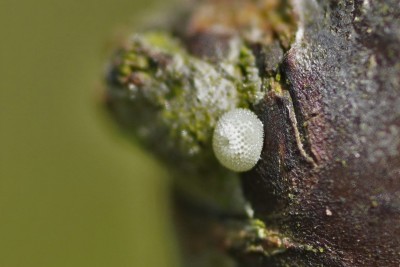
- Freshly-laid egg from video above
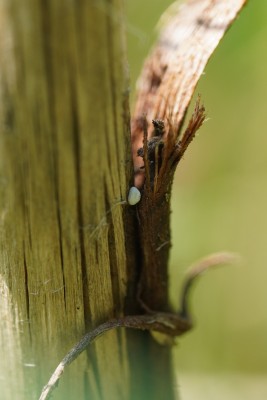
- Egg on shredded blackthorn sucker
As I’ve mentioned before, I believe that this particular site is on the southern-most edge of brown hairstreak distribution in the UK. It’s not floristically diverse by any means and is bordered by urban areas to the east, south and west, with a corridor of suitable habitat to the north, linking this site to a number of other known sites for brown hairstreak. I could be wrong, but I think this creates a kind of bottleneck in the landscape, where brown hairstreak have been corralled to, creating a higher-than-normal population density than would be expected at a site of this size. I’m particularly interested to understand whether brown hairstreak, or any other species show differences in their egg laying at the edge of their ranges. Please share any thoughts, experiences etc. if you have any!
I’ve also been trying to fill in some gaps to determine the distribution of this butterfly in and around the Brighton and Hove area and managed to find some eggs at five additional locations this winter, which has been very helpful in providing a clearer picture. A few weeks ago, I cycled to Worthing and stopped off at a few unvisited locations along the way that I thought would be worth checking for brown hairstreak. I ended up finding a number of eggs at Brooklands park, which borders Worthing beach. The southern-most eggs were found less than 100m from the beach, which raised the question of whether this could be the southern-most colony of brown hairstreak in Mainland UK.
Re: Max Anderson
Posted: Fri Feb 11, 2022 8:07 pm
by Wurzel
Some interesting reading and sterling work Max

It's great to imagine Brostreaks living so close to the beach and such a busy area. As for the it being the southern most colony I think that the colonies in Devon would count as those as they're on a lower line of latitude...these could be the most maritime though?

Have a goodun
Wurzel
Re: Max Anderson
Posted: Sat Feb 12, 2022 2:32 pm
by Katrina
Great work. Good to hear they are at Brooklands Park
Re: Max Anderson
Posted: Sun Feb 13, 2022 1:58 pm
by Max Anderson
Thanks Wurzel, yes, some of the South Devon records will certainly be on a lower latitude than any in Sussex. Not sure about closest proximity to the coast though..
Thanks Katrina - I managed to find them at 5 or 6 different locations across the entire park, as there are a number of small, isolated patches of blackthorn across the site. The more i look for them (and inevitably find them), the more it changes my mind about their habitat preferences. They're pretty much everywhere in their known range, even at sites that you wouldnt typically associate with brown hairstreaks. I'm curious about what drives their absence from the majority of East Sussex..
Cheers,
Max
Re: Max Anderson
Posted: Sun Feb 13, 2022 2:22 pm
by trevor
I live in East Sussex, on the edge of Hailsham. quite near me there is an area
that would appear perfect for Brown Hairstreaks ie Blackthorn throwing up suckers,
interspersed with Ash trees. To be honest the site looks as likely as Steyning.
But as far as I know there are none there.
The same goes for Purple Emperors, some good looking sites this far East, but no reports.
For many other species East Sussex is excellent.
Hope to see you around this year.
Trevor.
Re: Max Anderson
Posted: Mon Feb 14, 2022 11:24 am
by David M
Nice study, Max. Brown Hairstreak is a rather enigmatic species but it helps that the ova are far easier to locate than the adults.
We have a puzzling distribution in south Wales, with the butterfly only occurring in 'pockets' of the landscape and, sadly, disappearing from many areas possibly due to annual hedge flailing.
Ash die-back isn't helping either.

I wish you good luck in your efforts to further study this species.
Re: Max Anderson
Posted: Mon Feb 21, 2022 6:14 pm
by Max Anderson
White-letter hairstreaks
After some success in following larval developments of white-letter hairstreaks last year, I wanted to improve my ability to find the eggs of this species and keep track of a greater number of individuals through their development. Last winter I managed to find less than 10 eggs across 3 sites, which felt a little underwhelming. This was despite having some excellent resources at hand, most notably those of Jamie Burston, who had produced some outstanding work relating to Elm trees and the habits of white-letter hairstreaks (
https://www.sussex-butterflies.org.uk/s ... streak.php). I was also keen to start searching at an earlier stage, as to minimise the risk of damaging any developing buds, which can be particularly delicate in late winter.
Last winter, I found 7 Elms at my local park with some low-hanging branches, where I ended up finding 5 eggs. There were a number of other branches that were just out of reach, which would otherwise have effectively doubled my searching area. This winter, I came prepared...
During the summer, I got my hands on an old paint roller and a telescopic pole (0.6-1.2M). A friend of mine who is a metalworker was able to bend the end of the paint roller to create a hook. It works well for my needs, and It collapses down to a decent size that I can carry without it getting in the way. I’ve been cautious using it, as I’m wary of doing any damage to the elms, but I had no issues over the winter! I won't be using this once the buds start to open, as they're far too delicate.
At Hove park, I counted 41 eggs this winter (at a rate of 10.25 eggs per hr). this is in addition to 8 eggs found at other locations across Brighton and Hove after some quick, opportunistic searches while on walks. Unfortunately, I don’t have any measure of effort for my counts last year, so this year will have to be my baseline.

- Example of the accessibility of the branches, with a marked egg at head height.
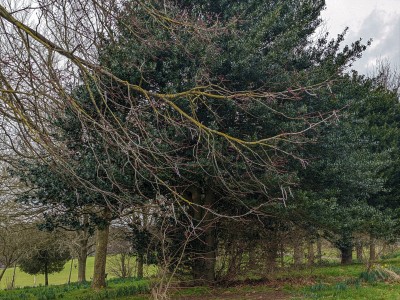
- 16 eggs in this shot - all marked with string
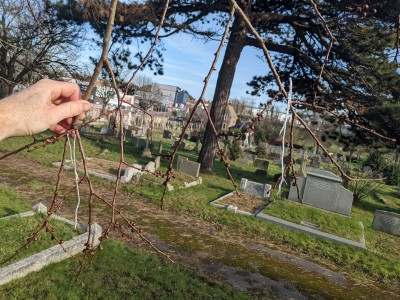
- Quick stop off at the graveyard
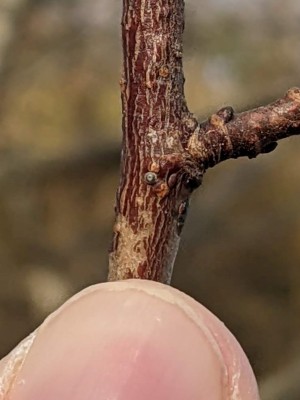
- Above, zoomed in
Eggs hatching
On my run today (21/2/2022), I came back through the park to check on the eggs and found that the first I checked had hatched. I went through all 41 eggs to find that 3 had hatched, with one resting up for the night. They must have hatched sometime between 18th-20th Feb, as I had checked them after my Thursday run as well. Last year, my first hatched egg was found on 1st March, however with such a small sample size, there’s little point in making any comparisons with the eggs from this year.
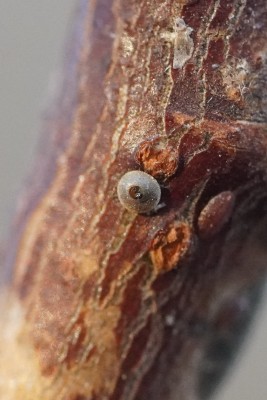
- Larva taking a break
Re: Max Anderson
Posted: Wed Feb 23, 2022 10:06 pm
by Wurzel
Interesting report Max

It's great to read about your efforts with the Whitters and also the 'working fix' you cam up with - that telescopic hook looks just the thing - I wonder if there's a way to rig a camera to something like that


Have a goodun
Wurzel
Re: Max Anderson
Posted: Fri Feb 25, 2022 10:15 am
by David M
Great observations, Max, along with a fair bit of ingenuity! The ova of this species are much duller and harder to spot than those of betulae, and no doubt largely found above head height which makes your idea of using a telescopic aid a real brainwave.
Looking forward to seeing more of this as spring unfolds.
Re: Max Anderson
Posted: Mon Mar 07, 2022 2:19 pm
by Max Anderson
Thanks Wurzel and David!
The reach of the telescopic pole is limited, and while it does give me a better chance of finding more eggs, I'm still only accessing fewer than 1% of all branches on any elm. I think coming up with an estimate of egg density per tree would go a long way in improving the accuracy of WLH population estimates. I'll have to make friends with some tree fellers...
Wurzel wrote: ↑Wed Feb 23, 2022 10:06 pm
that telescopic hook looks just the thing - I wonder if there's a way to rig a camera to something like that
I have come across a few attempts to rig something like this up, though it looks awfully cumbersome and is not something I'll be doing myself. It would certainly be interesting to capture some footage of tree-top activity.
Re: Max Anderson
Posted: Wed Apr 20, 2022 4:34 pm
by Max Anderson
Re: Max Anderson
Posted: Thu Apr 21, 2022 9:36 pm
by David M
First class stuff, Max. That UV light really does show them up easily doesn't it?
Re: Max Anderson
Posted: Fri Apr 22, 2022 6:01 pm
by kevling
Great Hairstreak observations Max. Very interesting.
Kind Regards
Kev
Re: Max Anderson
Posted: Mon May 30, 2022 4:53 pm
by Max Anderson
Over the last few months, I’ve spent the vast majority of my time behind a desk writing my PhD, but I’ve finally submitted and have now got some time to add some entries to the blog from the trips I've managed to squeeze in this year...
Holly blues, Orange-tips and Green hairstreaks
Seeing the first cuckooflowers emerge always gives me great excitement in anticipation of the year ahead. I had to wait some time before I would see my first butterfly this year, which happened in mid/late March, as a peacock flew past my third-floor flat window. I would then have to wait another month before I would be get to see another in the UK. A sunny weekend in mid-March brought a great emergence of feisty male holly blues, who had quickly established territories on ivy along the alleyway beside my flat.
A week or so later, I had a meeting at Knepp, and I set off early so I could spend some time looking for orange-tips. I always forget how much smaller they are when at rest, with their wings tucked in. Within seconds, I had found a fresh green-veined white, and then a few minutes later, a few orange-tips at rest on cuckooflower.
On the way home, I stopped off at Devil’s Dyke in Sussex to take advantage of the sunny weather. A good spot for green hairstreaks, with plenty of possible host plants in abundance along the slopes. After making my way down to the main path, stumbling across some early purple orchids, I saw some activity at the top of a particularly well sheltered Wayfaring tree. The males were nectaring from the flowers and disturbing eachother along the way, resulting in frequent re-shuffling between flowers. I suspect there were 9 or 10 males using this one small tree alone.
Further up the slopes, the line of hawthorn-dominated trees provides a wind-break and allows more activity from battling males. I sat watching for an hour or so, and eventually spotted a mating pair, given away by a feisty male, attempting to sneak in.
Re: Max Anderson
Posted: Mon May 30, 2022 6:19 pm
by trevor
Good to see your mating Green Hairstreaks, something I've never seen.
Also good to hear from you, dare say we'll meet in about four weeks time !.
Take care,
Trevor.
Re: Max Anderson
Posted: Tue May 31, 2022 7:32 am
by Max Anderson
Thanks Trevor. Not something I had managed to see for myself either until then.
Yes, I expect we will.
Re: Max Anderson
Posted: Tue May 31, 2022 10:36 am
by Benjamin
Nice update Max and glad to hear your PhD has been submitted!
Although sometimes quite busy Devil’s Dyke is a great place for spring butterflies, and particularly green hairstreak as you clearly know! It’s not uncommon to see 50+ along the valley floor at peak season. Also it scores highly for having a good pub next to the car park!
Looking forward to seeing what you get up to now you’re freed up a little more.
Re: Max Anderson
Posted: Tue May 31, 2022 7:48 pm
by Matsukaze
I love the photographs of the Green Hairstreaks in flight, which have the quality of paintings about them.
Delighted to read of someone actually having success with telescopic poles in looking for hairstreak early stages - I tried this myself using a surplus-to-requirements pole for cleaning upstairs windows, now no longer usable after a misguided attempt to beat for larvae...

